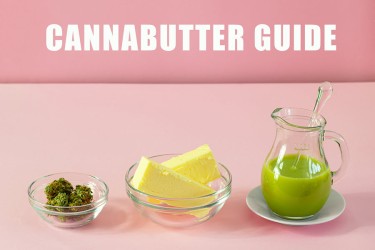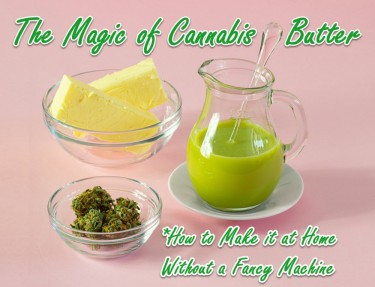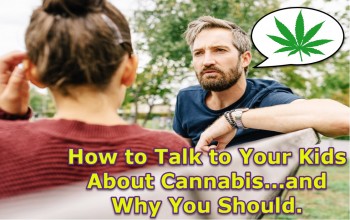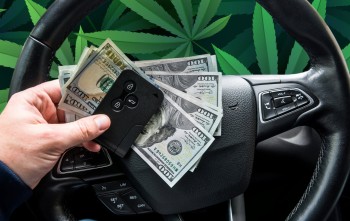Did you know? Apart from buying edibles at retail stores or dispensaries, you can make some delicious ones at home. And it all starts from the basic, the best, the allrounder - Cannabutter. To make the process simpler, our weed butter enthusiasts at Online Marijuana Card have documented the perfect recipe for you to follow.
In this blog, we’ll start by covering some basics about cannabutter. If you wish to avoid that, you can directly jump to the recipe. (Use the table of contents).
What is Cannabutter?
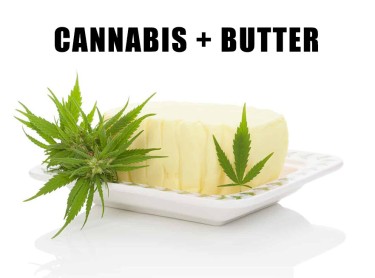
Cannabutter is cannabis-infused butter, one of the easiest and most commonly DIY-ed edibles. This is also one edible that is used to make a multitude of other delicious edibles at home.
The cannabis flower used needs to be infused with butter, coconut oil, olive oil, or even vegetable oil. This is because the cannabinoid THC, found commonly in cannabis flowers, needs to bind with fat molecules that are abundantly present in butter and these oils. At the same time, butter has a rich flavor and is versatile to use, making it the perfect choice to combine with cannabis.
This is to say, that while butter is the best option, there are other alternatives for you to use.
How to Make Cannabutter?
The process is easy to follow but a little time-consuming. With a little patience, even a beginner can make some incredibly delicious and potent cannabutter.
It is best remembered that before you make cannabutter, you need to decarboxylate your cannabis flower.
Decarbing Cannabis - Before infusing the weed with butter, you must first decarboxylate the cannabis flowers. What this means is that the flower will go through a heating process that will convert the THCA into THC, thereby activating the cannabinoid.
If you consume the flower in its base form or infuse it with butter without decarboxylating it, you won’t experience much. Without the heating process, the cannabinoids present in the cannabis will remain dormant and you won’t feel any psychoactive effects.
To experience the “high-like” effects, it is crucial to convert THCV into THC. We’ll explain the process of decarboxylating your cannabis further in the blog.
Before we get into the recipe, here are some things and ingredients you’ll need during the process:
Material Required
-
Oven
-
Baking Sheet
-
Parchment Paper
-
Saucepan (or Stock Pot, Double Boiler, Slow Cooker)
-
Mesh Strainer (or Cheesecloth)
-
Jar
Ingredients Required
-
1 Cup Cannabis Flower (A Quarter Ounce - 7grams)
-
1 Cup of Butter (2 Sticks)
-
1 Cup of Water
Recipe on How to Make Cannabutter
While following the recipe, ensure you’re using high-cannabis strain and butter. The quality of both these ingredients will determine the quality of your cannabutter. Also, avoid using margarine or fat-free butter. The cannabinoid (THC) needs to bind with fat molecules to become digestible and show effects.
Here are 7 steps to make weed butter:
Step 1: Grind or Break the Flower
You can use a grinder for this purpose as they will break the cannabis flower down to consistent small bits, and won’t waste any time. Do not grind the flower into a powder as it will get through the mesh strain and into your butter. (You do not want pieces of the flower in your butter).
Grinding the flower before decarbing makes the process easier. Grinding a toasty flower can be a little difficult and can even ruin your grinder.
Step 2: Decarboxylate the Cannabis Flower
-
Start by preheating the oven to 230-245ºF.
-
Grab your non-stick baking sheet, cover it with parchment paper and place the ground cannabis on it.
-
Heat the cannabis in the oven for 30-40 minutes.
-
Continue stirring the ground cannabis every 5-10 minutes to ensure it is decarbed evenly.
-
Do not exceed the 40-minute limit. Overheating might damage the overall efficacy of the cannabinoids and terpenes.
Step 3: Melt the Butter
Meanwhile, melt 1 cup (2 sticks) of butter in a saucepan and add 1 cup of water to it. This will help the butter heat more evenly, without scorching. It is preferable to cook the butter at 150-200ºF. Let the butter simmer on low heat and check the temperature with a thermometer if unsure.
Step 4: Add Cannabis to the Butter
Once the butter is melted, add the decarbed cannabis into it to start the infusion. Cover the pot with a lid.
Step 5: Simmer for a Few Hours
Let the concoction simmer on low heat for approximately 2-3 hours. For a more potent cannabutter, increase the time duration to 4 hours. Add more water if you wish to extend the time duration. Also, ensure that you stir the mixture after some time to avoid burning. Do not let the butter come to a boil.
Step 6: Strain the Mixture
Cover a jar with a mesh cloth and pour the weed butter through it. Once fully strained, use the leftover as compost or throw it away. Do not try to squeeze too much butter out of the leftover. This might push some undesirable components into the butter and ruin the overall taste.
Step 7: Refrigerate
First, allow the cannabutter to cool down for 30 minutes at room temperature. Then transfer the jar to the fridge. If there is any excess water left behind, it’ll be clearly visible once the butter solidifies. You can carefully remove the layer of water on the bottom of the jar.
Following these 7 simple steps, you should have your cannabutter, ready to be consumed or used to make other edibles.
Can You Calculate the Edible Dosage Precisely?
Dosing homemade cannabutter can be difficult. Not because you’re unaware of how much THC or CBD is in the edible but because even with those quantities you can never be precisely certain about its potency.
The potency of your cannabutter depends on the quality of your cannabis and butter, the cannabis strain used, as well as the cooking technique, and the time period. As you change these parameters, the potency of your cannabutter might also change. However, that does not mean you cannot make a rough estimate of the potency and use it as a guide.
To calculate the amount of THC in the cannabutter, you should be aware of how much cannabis you’ve used to make the butter and the amount of THCV in it. Dispensary-bought cannabis comes with a certificate of analysis. This lab result will have details of the total quantities of all cannabinoids, including THCV and THC. To ensure that you only buy quality cannabis from licensed sellers, you can look up your local dispensary at cannabis.net/find/dispensary.
You can find a variety of cannabutter ratio calculators that require you to enter the amount of THCV or THC in the cannabis flower you’ve used, the total quantity of cannabis used, and the amount of butter that you’ve infused with the cannabis.
The least you can do is calculate the maximum amount of THC that will be present in the butter. To do this, follow a simple formula:
-
(Grams of flower) x 1000 x (Percentage of THCA) = Total Milligrams of THCA
This means, with 7gram of flower that has a THCA potency of 20%, you’ll have 1400 mg of THCA (7g x 1000 x 0.2 = 1400mg)
-
The conversion rate of THCA to THC is around 88% (the rest is lost during the decarboxylation process)
1400 mg x 0.88 = 1232 mg of THC
This is the amount of THC present in the flower before being infused with the butter.
-
During home cooking, it is expected that only 70% of the THC is extracted efficiently. Keeping this stat in mind,
1232 mg x 0.7 = 862.4 mg of THC
This is the quantity of THC that is expected to be in the butter. Keeping this formula in mind, you can decide if you want a strain with 15% THC or 25% THC. Only experienced cannabis consumers should opt for any strain with more than 20% THC. Also, be careful if your experience has been restricted to smoking cannabis. Edibles are much more potent and have a long-lasting effect, so make your choice carefully.
To make cannabis flower quantities clearer, read this blog about weed measurements.
Cannabis to Butter Ratio: Making the Weed Butter Milder or Stronger
For personal consumption, being aware of the potency of your cannabis flower can help you figure out the quantity you need. Generally, we recommend using a 1:1 ratio of cannabis and butter, which will amount to 1 cup of cannabis and 1 cup of butter. If you want to experience milder effects, you can cut down the cannabis to ½ cup or ¾ cup while the quantity of butter remains the same.
If you want to experience stronger effects, you can increase the dose of cannabis (1 ¼ or 1 ½ cup of weed and 1 cup of butter).
If the cannabutter is still too strong, you can mix it with regular butter, while spreading it on toast or adding it to any edible. If the cannabutter is weak, there isn’t much you can do except consume more of it to experience the effects.
How to Make Edibles With Cannabutter?
Can you remember how many things you bake or consume that have butter in them? Plenty would be our guess.
Now, you can use cannabutter in just every bit of them. Once you’ve infused the cannabis with the butter, you can use it to make brownies, cookies, cakes, and more or simply spread it over some toast.
If you’re hoping to bake some potent edibles, you might have to double up on your cannabis dosage in the butter. On the contrary, if you’re hoping for some mild effects, prefer mixing the cannabutter with regular butter to manage the dosage.
If you’re hoping to bake some potent edibles, you might have to double up on your cannabis dosage in the butter. This butter is best used in smaller quantities,
Some Things to Remember
-
Edibles made at home tend to be more potent than you expect. It is always advised to go slow and steady so you do not end up experiencing negative highs.
-
At the same time, if you don’t follow the procedure precisely, the effects might fall short of satisfactory.
-
You must wait 2-3 hours between doses. Edibles do not take effect in the first few hours but eventually hit you altogether. You do not want to overwhelm yourself with the effects.
-
If your cannabutter seems extremely potent, you can add regular butter to it. This will change the ratio of cannabis to butter, leading to milder effects.
-
Skipping out on decarboxylation might still provide some benefits of cannabis. This is because the cannabis does get heated while being infused with butter. This cannabutter, however, will not be very potent, proving to be the perfect fit for newbies.
Now you know how to make cannabis butter!
Now that you know how easy the process of making weed butter is, you can go ahead and try your hand at it. Once done, spread it over a piece of toast and wait for the effects to take place. This will help you evaluate just how your body reacts to its potency. You’ll now be more aware of how much of the cannabutter must be used to make other edibles.
MORE ON CANNABIS-INFUSED BUTTER, READ ON..
HOW TO MAKE CANNABIS BUTTER AT HOME WITHOUT THE MESS!

